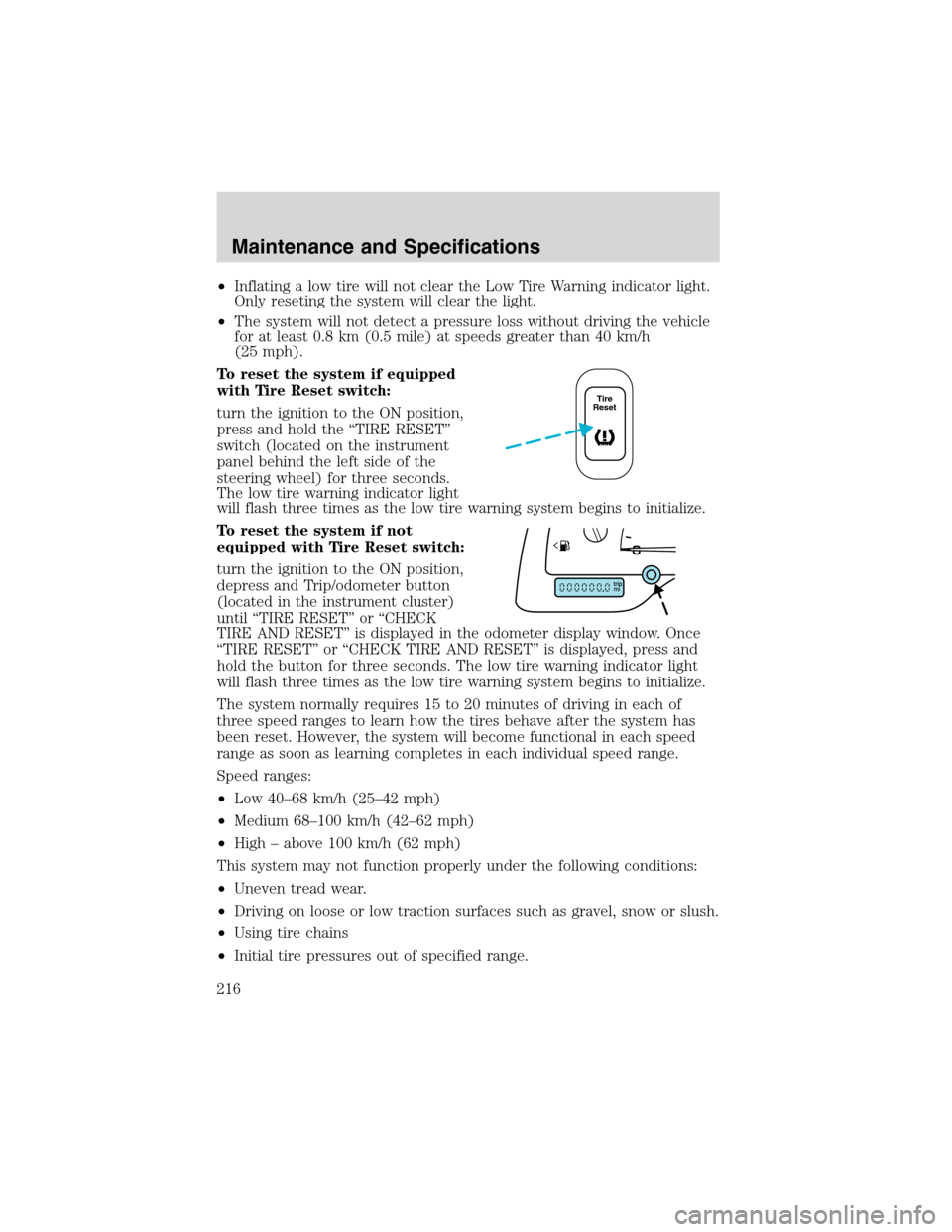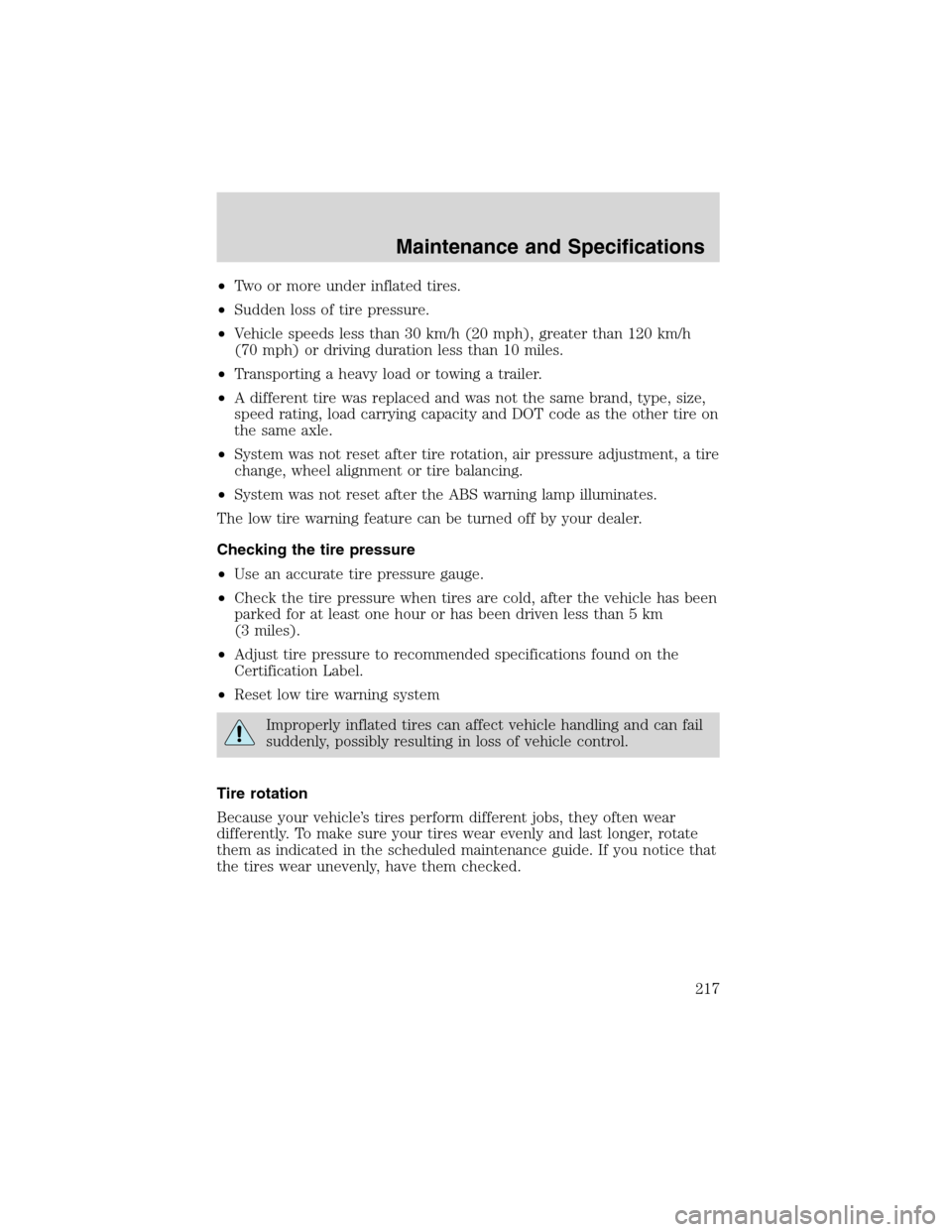Page 216 of 240

•Inflating a low tire will not clear the Low Tire Warning indicator light.
Only reseting the system will clear the light.
•The system will not detect a pressure loss without driving the vehicle
for at least 0.8 km (0.5 mile) at speeds greater than 40 km/h
(25 mph).
To reset the system if equipped
with Tire Reset switch:
turn the ignition to the ON position,
press and hold the“TIRE RESET”
switch (located on the instrument
panel behind the left side of the
steering wheel) for three seconds.
The low tire warning indicator light
will flash three times as the low tire warning system begins to initialize.
To reset the system if not
equipped with Tire Reset switch:
turn the ignition to the ON position,
depress and Trip/odometer button
(located in the instrument cluster)
until“TIRE RESET”or“CHECK
TIRE AND RESET”is displayed in the odometer display window. Once
“TIRE RESET”or“CHECK TIRE AND RESET”is displayed, press and
hold the button for three seconds. The low tire warning indicator light
will flash three times as the low tire warning system begins to initialize.
The system normally requires 15 to 20 minutes of driving in each of
three speed ranges to learn how the tires behave after the system has
been reset. However, the system will become functional in each speed
range as soon as learning completes in each individual speed range.
Speed ranges:
•Low 40–68 km/h (25–42 mph)
•Medium 68–100 km/h (42–62 mph)
•High–above 100 km/h (62 mph)
This system may not function properly under the following conditions:
•Uneven tread wear.
•Driving on loose or low traction surfaces such as gravel, snow or slush.
•Using tire chains
•Initial tire pressures out of specified range.
Tire
Reset
Maintenance and Specifications
216
Page 217 of 240

•Two or more under inflated tires.
•Sudden loss of tire pressure.
•Vehicle speeds less than 30 km/h (20 mph), greater than 120 km/h
(70 mph) or driving duration less than 10 miles.
•Transporting a heavy load or towing a trailer.
•A different tire was replaced and was not the same brand, type, size,
speed rating, load carrying capacity and DOT code as the other tire on
the same axle.
•System was not reset after tire rotation, air pressure adjustment, a tire
change, wheel alignment or tire balancing.
•System was not reset after the ABS warning lamp illuminates.
The low tire warning feature can be turned off by your dealer.
Checking the tire pressure
•Use an accurate tire pressure gauge.
•Check the tire pressure when tires are cold, after the vehicle has been
parked for at least one hour or has been driven less than 5 km
(3 miles).
•Adjust tire pressure to recommended specifications found on the
Certification Label.
•Reset low tire warning system
Improperly inflated tires can affect vehicle handling and can fail
suddenly, possibly resulting in loss of vehicle control.
Tire rotation
Because your vehicle’s tires perform different jobs, they often wear
differently. To make sure your tires wear evenly and last longer, rotate
them as indicated in the scheduled maintenance guide. If you notice that
the tires wear unevenly, have them checked.
Maintenance and Specifications
217
Page 219 of 240

Make sure that all replacement tires are of the same size, type,
load-carrying capacity and tread design (e.g.,“All Terrain”,
“Touring”, etc.), as originally offered by Ford.
Do not replace your tires with“high performance”tires or larger
size tires.
Improperly inflated tires can affect vehicle handling and can fail
suddenly, possibly resulting in loss of vehicle control, vehicle
rollover and/or personal injury.
Tires that are larger or smaller than your vehicle’s original tires may also
affect the accuracy of your speedometer.
SNOW TIRES AND CHAINS
Driving too fast for conditions creates the possibility of loss of
vehicle control. Driving at very high speeds for extended periods
of time may result in damage to vehicle components.
Snow tires must be the same size and grade as the tires you
currently have on your vehicle.
The tires on your vehicle have all weather treads to provide traction in
rain and snow. However, in some climates, you may need to use snow
tires and chains. If you need to use chains, it is recommended that steel
wheels (of the same size and specifications) be used as chains may chip
aluminum wheels.
Follow these guidelines when using snow tires and chains:
•Do not use tire chains with 235/60R16 and P235/55R17 size tires.
•Use only SAE Class S chains.
•Install chains securely, verifying that the chains do not touch any
wiring, brake lines or fuel lines.
•Drive cautiously. If you hear the chains rub or bang against your
vehicle, stop and re-tighten the chains. If this does not work, remove
the chains to prevent damage to your vehicle.
•If possible, avoid fully loading your vehicle.
Maintenance and Specifications
219
Page 228 of 240
Tire step
Travel equipment
All weather floor mats
Cargo organizer
Cargo logic—premium cargo organizer
Cellular phone holder
Cellular phone hands free ssytem with voice recognition
Console
Factory luggage rack adaptors (Bike, ski, etc.)
First aid kit
Framed luggage covers
Highway safety kit
Inside rear view mirror with compass (with and without temperature
display)
Luggage/cargo basket
Navigation system
Raised cross bars (roof rack)
Rear seat entertainment system (DVD)
Soft luggage cover
Trailer hitch (Class II)
Trailer hitch bars and balls
Trailer hitch mount bike carrier
Trailer hitch receiver cover
Trailer hitch wiring adaptor
Trailgate table/ adapter.
Protection and appearance equipment
Cargo liners, interior
Carpet floor mats
Door edge guards
Flat splash guards
Front end covers (full and mini)
Accessories
228